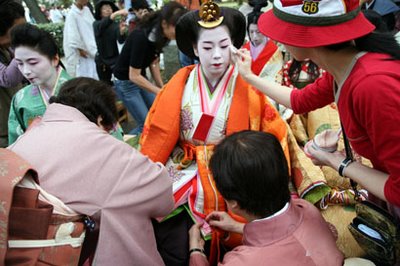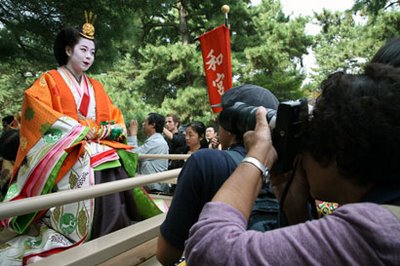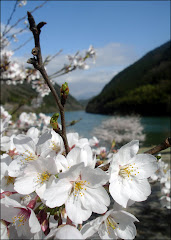
A Heian period princess, dressed in the 12 layered kimono popular with the imperial court in that era, patiently waits as the final touches are applied to her make up and kimono before participating in Kyoto's Jidai Matsuri: The Festival of Ages.

During the Heian period (794-1192), the subtle matching of different colored robes was considered a great skill, an expression of artistic sensibility that revealed the character of the wearer. In a woman, this skill was more highly valued than her ethical or moral character, and even held more sway than the physical features she was born with. The Heian society was “on the whole governed by style rather than by moral principles”.
 Colors and patterns of the "juni-hitoe" (12 layers- a rather arbitrary number, as some women wore as many as 20) reflected many things, including: rank, seasons, directions, virtues, and elements of the earth as they related to spirits of nature. The multiple layers also helped in staying warm in winter. Eventually, sumptuary laws of the Edo Period standardized the number of layers to five.
Colors and patterns of the "juni-hitoe" (12 layers- a rather arbitrary number, as some women wore as many as 20) reflected many things, including: rank, seasons, directions, virtues, and elements of the earth as they related to spirits of nature. The multiple layers also helped in staying warm in winter. Eventually, sumptuary laws of the Edo Period standardized the number of layers to five.
Fans carried by ladies of the Heain Imperial court.

Over 2,000 Kyoto residents take part in the great procession of the Festival. Many maiko and geisha also make an appearance, dressed as some of the most famous women of Japanese history.

The costumes used in the festival are authentic, created according to the techniques used during the period, and are valued at over $25 million.






3 comments:
I wish I could have gone with you, but you know, maybe you wouldn't have had the same experience. I like how you included detail pictures of the fabric. I always think that's important in telling a photo story.
Nos vemos el fin de semana y oh - donde estan mis fotos, foo? -Happy Pumpkinhead
Wow. I miss autumn in Japan now. I'd forgotten (all too soon) about the colours.
I love all the pretty colors...
Post a Comment